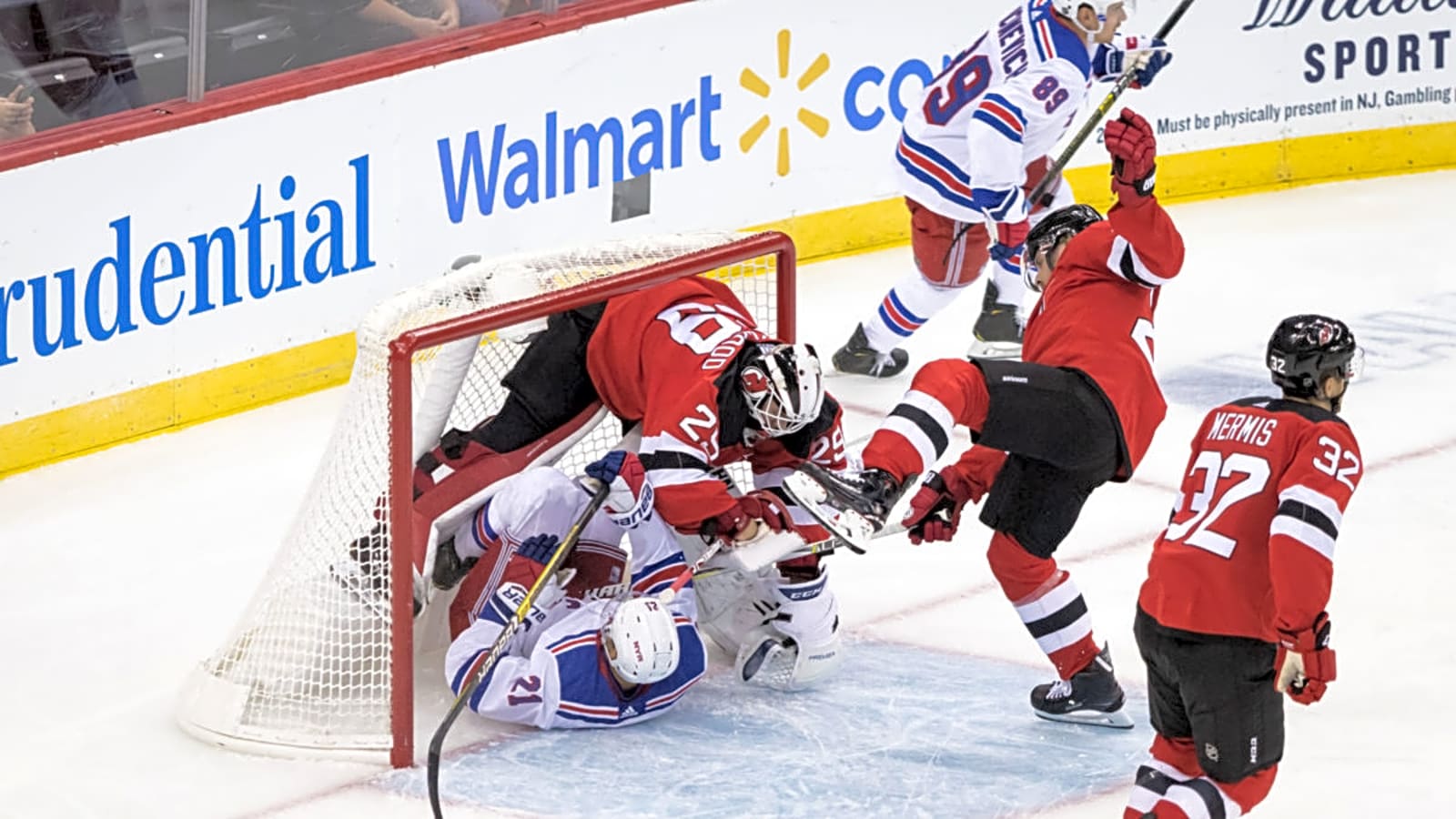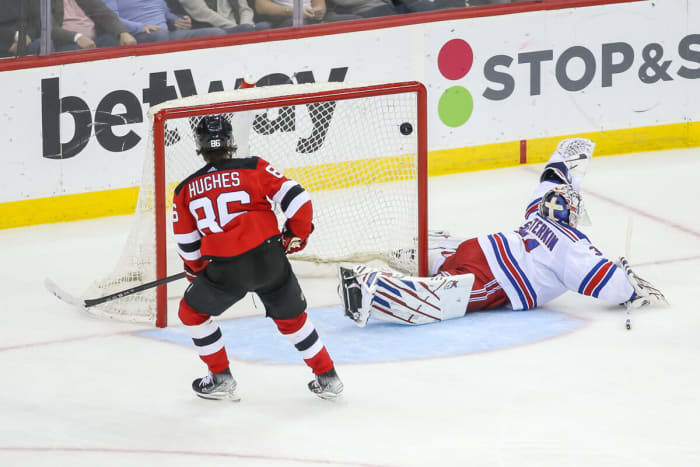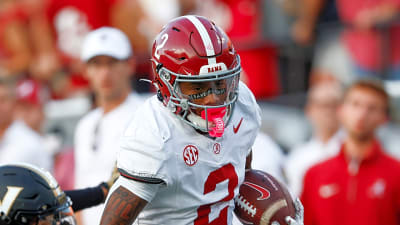
Few rivalries in sports carry the emotional weight, regional pride and generational bitterness of the New Jersey Devils and New York Rangers. For over 40 years, this cross-river rivalry, known as the Battle of the Hudson, has defined East Coast hockey, producing unforgettable moments and a deep-rooted shared history for the players and fans. From heartbreak in the ’90s to playoff redemption in the 21st century, the rivalry has evolved into a bitter feud that has defined hockey in the Metropolitan area for decades.
There’s no clear origin to the hatred, but somewhere between the short distance of Madison Square Garden and the Prudential Center, a blood feud was born. Ask any Devils or Rangers fan, and they’ll tell you: de spising the other side isn’t a choice – it’s a birthright.
The Rivalry Begins: 1980-1990
The Devils were born in 1982, a relocated franchise from Colorado that had struggled to find stability. Their arrival in East Rutherford was met with skepticism – why plant a fledgling team just 11 miles away from the storied Original Six Rangers?
From day one, the Devils had something to prove. They were mocked for their subpar play and virtually non-existent fan base. The Blue Shirts were proud and territorial, and viewed New Jersey as an encroachment on their territory. On the ice, both teams were on different trajectories.
The Rangers, while struggling to win a Cup, still made frequent playoff appearances throughout the ’80s. In contrast, the Devils spent much of the decade near the bottom of the standings, often missing the playoffs entirely and finishing with losing records. Behind the scenes, the Devils were laying a foundation, and in 1987, Lou Lamoriello was hired as general manager — a move that changed the direction of the franchise. He instilled discipline, overhauled scouting and player development, and brought a long-term vision focused on defense, structure, and winning. In the 1987-88 season, the Devils broke through, clinching their first playoff berth on the final day of the regular season thanks to a game-winning overtime goal by John MacLean. They showed their potential, and many fans in the Jersey area switched over to support their home team, causing a deeper divide between the Devils and Rangers.
Decade of Struggle for the Devils
By 1990, the groundwork for the rivalry was set.
This decade saw the rivalry explode. Under the guidance of Lamoriello and head coach Jacques Lemaire, combined with the stardom of Martin Brodeur in net and Scott Stevens leading a physical blue line, the Devils became serious playoff contenders. Their style of play clashed with the offensively talented Rangers.
Over the course of the decade, the Devils and Rangers faced off in the playoffs three times, beginn ing with their inaugural postseason battle in the 1991-92 campaign. The first matchup between the two lived up to the hype, with the Rangers ultimately coming out to take the series with a 4-3 win.
In the 1993-94 season, the Rangers once again triumphed over the Devils in a thrilling Game 7, sealed by Stéphane Matteau’s unforgettable double-overtime goal that punched their ticket to the Stanley Cup Final. New York would go on to capture its first championship in 54 years, while the Devils were left heartbroken and hungrier than ever for redemption.
The third Devils-Rangers playoff series took place in 1997, when the star-studded Rangers, led by Mark Messier , Wayne Gretzky, and Mike Richter, eliminated the Devils in the Eastern Conference semifinals.
The 2000s: Where the Devils Find Success
The 2000s marked a period of dominance for the Devils in the rivalry. Between 2000 and 2003, New Jersey added two more Stanley Cups and rout inely outperformed the Rangers in both head-to-head matchups and the standings. While the Devils were firmly established as perennial contenders, the Rangers endured a playoff drought from 1997 to 2006, watching from the sidelines as the Devils found their success.
“The hatred? I couldn’t even put a number on it. The hatred was off the charts,” said Ken Daneyko, longtime Devils blueliner and current broadcaster for the team. “It was an unwritten rule that you wouldn’t even say their name.”
In 2006, the two organizations returned to the postseason, where the Devils swept the Rangers 4-0 for the first time in franchise history. Brodeur became a constant tormentor of Rangers fans, while names like Patrik Elias, Scott Niedermayer, and John Madden became synonymous with New Jersey’s methodical, crushing style of play.
In 2008, the physicality picked up.
Tensions between the teams were at their peak, mainly due to Sean Avery. Avery, the Rangers’ resident agitator, inserted himself directly into the heart of the series with one of the most controversial moments in playoff history. During Game 3, Avery slotted himself in front of Brodeur during a Rangers power play, waving his hands and stick in an attempt to distract Brodeur. The league issued an unsportsmanlike conduct rule (now known league-wide as the “ Sean Avery Rule“) to prevent players from engaging in actions that deliberately distract or taunt the goaltender. After the series in which the Rangers won 4-1, Brodeur refused to shake Avery’s h and, adding a new level of hostility between the teams.
The 2012 Showdown
The rivalry surged back to life in 2012, when the Devils and Rangers met once again in the Eastern Conference Final. For the first time since 1994, the two teams met with a trip to the Stanley Cup Final on the line. Coming in, the Rangers were the top seed in the East, stacked with veteran talent and led by the calm, talented presence of Henrik Lundqvist in net. The Devils, meanwhile, had entered the playoffs as the sixth seed – gritty, underestimated, and anchored by the legendary Brodeur, playing in his final postseason appearance.
Tensions were high after the last regular-season matchup between the two teams ended in a line brawl just moments after puck drop. The playoffs were no different, as scrums, heavy hits and relentless forechecking marked each game. While the Devils found themselves in a tough spot thanks to the new offensive addi tion of Chris Kreider, they held on to their resentment from decades ago and were ready to flip the script that haunted them.
Regulation ended in a 2-2 deadlock. Less than two minutes into overtime, rookie sensation Adam Henrique found the puck off a scramble in front, pushing it past Lundqvist, clinching the series and sending The Rock into absolute chaos. In that instant, Doc Emrick’s legendary “Henrique! It’s over!” echoed into a moment that Devils fans will never forget.
2013 – Present Day
After the emotional high of 2012, both franchises entered a period of transition. The Devils cycled through coaches and a constantly changing roster, while the Rangers were working on their own transition. Departures of veterans from both teams saw new faces emerge, and a new era began.
While there was no postseason fuel for the rivalry until 2023, the tension never waned in the regular season. Fights, chirps and large crowds were a constant for the cross-river rivals, even when both teams were in their rebuilds. 12 years after the first, a modern era line brawl broke out at the Garden. The fight was a long time coming after Matt Rempe elbowed Jonas Siegenthaler in the head, resulting in a four-game suspension and a concussion, respectively.
The tension was building, and when the Devils faced the Rangers less than a month later, the gloves literally came off. Both sides sent out their fourth liners off the draw, and all ten players on the ice went head-to-head. There were eight game misconducts, 18 penalties, 10 major penalties and 130 penalty minutes. The Devils combined for 86 penalty minutes in the first period, the most in Devils franchise history. The Rangers went on to sweep the Devils in the 2023-24 regular season series, but the Devils responded in 202 4-25, going 3-0-1 and shutting out the Blue Shirts twice.
Looking Ahead
For more than 40 years, the Devils–Rangers rivalry has transcended the ice, evolving into a cultural clash — a relentless test of pride and the heartbeat of East Coast hockey. Even when they’re not facing each other, Devils and Rangers fans carry the animosity like a badge of honor – because in this rivalry, the hatred is constant.

Fans on both sides are anxiously awaiting the next chapter of the Hudson River Rivalry, but they’ll have to be patient. The Devils and Rangers are scheduled to meet just three times in the upcoming season, all in March. With playoff positioning likely on the line, each matchup could carry added weight, ensuring that, when they do meet, the intensity will be as fierce and alive as ever.
More must-reads:
- Maple Leafs' Matthew Knies could be beneficiary of Mitch Marner move
- Mets manager confirms veteran pitcher done for the season due to 'pretty significant' injury
- The 'Season TD pass leaders by NFL team' quiz
Breaking News
Trending News
Customize Your Newsletter
 +
+
Get the latest news and rumors, customized to your favorite sports and teams. Emailed daily. Always free!








